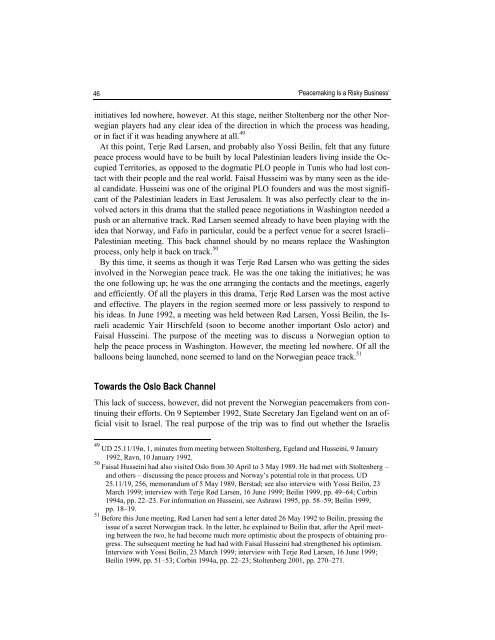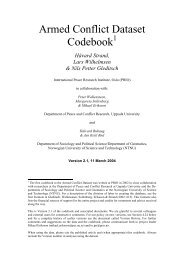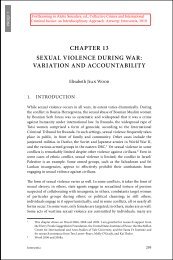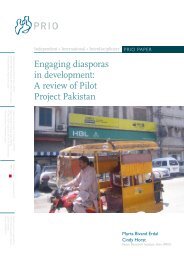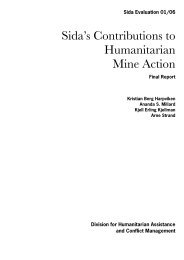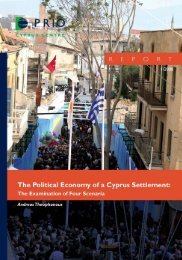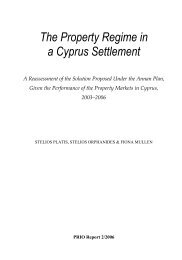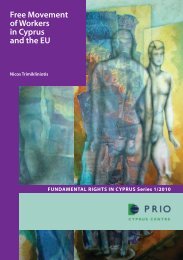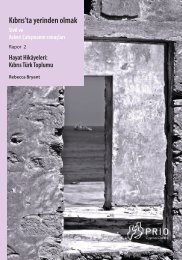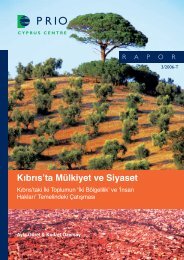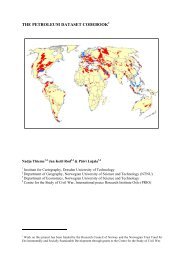Peacemaking Is a Risky Business - PRIO
Peacemaking Is a Risky Business - PRIO
Peacemaking Is a Risky Business - PRIO
Create successful ePaper yourself
Turn your PDF publications into a flip-book with our unique Google optimized e-Paper software.
46 ‘<strong>Peacemaking</strong> <strong>Is</strong> a <strong>Risky</strong> <strong>Business</strong>’initiatives led nowhere, however. At this stage, neither Stoltenberg nor the other Norwegianplayers had any clear idea of the direction in which the process was heading,or in fact if it was heading anywhere at all. 49At this point, Terje Rød Larsen, and probably also Yossi Beilin, felt that any futurepeace process would have to be built by local Palestinian leaders living inside the OccupiedTerritories, as opposed to the dogmatic PLO people in Tunis who had lost contactwith their people and the real world. Faisal Husseini was by many seen as the idealcandidate. Husseini was one of the original PLO founders and was the most significantof the Palestinian leaders in East Jerusalem. It was also perfectly clear to the involvedactors in this drama that the stalled peace negotiations in Washington needed apush or an alternative track. Rød Larsen seemed already to have been playing with theidea that Norway, and Fafo in particular, could be a perfect venue for a secret <strong>Is</strong>raeli–Palestinian meeting. This back channel should by no means replace the Washingtonprocess, only help it back on track. 50By this time, it seems as though it was Terje Rød Larsen who was getting the sidesinvolved in the Norwegian peace track. He was the one taking the initiatives; he wasthe one following up; he was the one arranging the contacts and the meetings, eagerlyand efficiently. Of all the players in this drama, Terje Rød Larsen was the most activeand effective. The players in the region seemed more or less passively to respond tohis ideas. In June 1992, a meeting was held between Rød Larsen, Yossi Beilin, the <strong>Is</strong>raeliacademic Yair Hirschfeld (soon to become another important Oslo actor) andFaisal Husseini. The purpose of the meeting was to discuss a Norwegian option tohelp the peace process in Washington. However, the meeting led nowhere. Of all theballoons being launched, none seemed to land on the Norwegian peace track. 51Towards the Oslo Back ChannelThis lack of success, however, did not prevent the Norwegian peacemakers from continuingtheir efforts. On 9 September 1992, State Secretary Jan Egeland went on an officialvisit to <strong>Is</strong>rael. The real purpose of the trip was to find out whether the <strong>Is</strong>raelis49 UD 25.11/19ø, 1, minutes from meeting between Stoltenberg, Egeland and Husseini, 9 January1992, Ravn, 10 January 1992.50 Faisal Husseini had also visited Oslo from 30 April to 3 May 1989. He had met with Stoltenberg –and others – discussing the peace process and Norway’s potential role in that process. UD25.11/19, 256, memorandum of 5 May 1989, Berstad; see also interview with Yossi Beilin, 23March 1999; interview with Terje Rød Larsen, 16 June 1999; Beilin 1999, pp. 49–64; Corbin1994a, pp. 22–23. For information on Husseini, see Ashrawi 1995, pp. 58–59; Beilin 1999,pp. 18–19.51 Before this June meeting, Rød Larsen had sent a letter dated 26 May 1992 to Beilin, pressing theissue of a secret Norwegian track. In the letter, he explained to Beilin that, after the April meetingbetween the two, he had become much more optimistic about the prospects of obtaining progress.The subsequent meeting he had had with Faisal Husseini had strengthened his optimism.Interview with Yossi Beilin, 23 March 1999; interview with Terje Rød Larsen, 16 June 1999;Beilin 1999, pp. 51–53; Corbin 1994a, pp. 22–23; Stoltenberg 2001, pp. 270–271.


